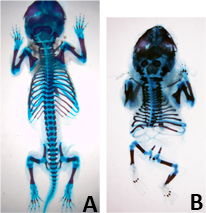New study reveals mechanisms behind trunk to tail transition in vertebrates

One of the most remarkable anatomical differences among vertebrate bodies is the relative size of their neck, trunk and tail. This can be illustrated by comparing the bodies of a typical snake and of a long tailed lizard. They are both very long and superficially similar. However, most of the snake's body is a trunk full with organs of the digestive, excretory and reproductive systems, whereas the largest part of the lizard's body is a muscular tail. These different body plans are genetically determined during embryonic development. In the latest issue of the journal Developmental Cell, Moisés Mallo and his group at the Instituto Gulbenkian de Ciência (IGC), Portugal, showed that the trunk to tail transition is intrinsically associated with the induction of the legs and the embryonic cloaca, and that this process is coordinated by a genetic cascade triggered by the signaling factor Gdf11. This study may contribute to understand some congenital human syndromes that lead to malformations in the lower part of the body.
During embryonic development, the body is made progressively starting from the head and ending in the tail. This process depends on the activity of a group of cells (known as axial progenitors) located at this most posterior end of the embryo that produce new tissues as it grows. After the head and neck are made, these progenitors engage in making the trunk, which includes the coordinate production of most of the animal's vital organs. At a particular point, the embryonic growth program changes and starts producing tail tissues instead of the trunk. This change occurs at the same time as the embryo forms the cloaca (the opening end of digestive, reproductive and urinary tracts) and the legs (more generically known as hindlimb). Moisés Mallo and his team found that the production of the cloaca and the legs is an intrinsic component of the trunk to tail transition and identified several of the key regulators of this process. They found that Gdf11 signaling stays at the top of the genetic hierarchy regulating the trunk to tail transition. Moisés Mallo's team showed that if Gdf11 is genetically inactivated in the mouse, the animals have longer trunks and their legs are located further away from the arms (or forelimbs) than in normal mice. When in the complementary experiment they forced the premature activation of Gdf11, the result was just the opposite: extremely reduced trunks and the hindlimbs located just next to the forelimbs.
"Our jaws almost touched the floor when we first saw those embryos because such strong alterations in the leg position have never been observed before" says Moisés Mallo.
These researchers also identified some of the key pieces involved in the execution of the program initiated by Gdf11 that ends the trunk and starts the tail. One of the most interesting of those pieces is the gene Isl1 (Islet 1). Gdf11 activates this gene specifically in the subgroup of axial progenitors responsible for making the internal organs in the trunk. The consequence of Isl1 activation is that these progenitors are now forced to form cloaca and hindlimbs instead of organs. This indicates that the vertebrate legs are actually the consequence of the way Isl1 manages to stop this group of progenitors from making internal organs, which are not anymore required in the tail.
Mallo's group work also gives an additional message: the genetic program regulating the trunk to tail transition must be perfectly coordinated in time and space because its alteration leads to a wide spectrum of malformations in the lower end of the body, typically affecting the vertebral column and the gastrointestinal, reproductive and urinary tracts. These malformations closely reproduce the clinical characteristics of human pathologies such as the caudal regression syndrome or the spinal segmental dysgenesis, indicating that they might originate from alterations in the trunk to tail transition during embryonic development.
Moisés Mallo says: "What we found might be important not only to understand the mechanisms that generate the wide anatomical diversity among vertebrate species, but might also provide important clues to understand some of these congenital human syndromes"
More information: Jurberg, A. et al. 2013) Switching Axial Progenitors from Producing Trunk to Tail Tissues in Vertebrate Embryos, Dev. Cell. (dx.doi.org/10.1016/j.devcel.2013.05.009)
Journal information: Developmental Cell
Provided by Instituto Gulbenkian de Ciencia



















